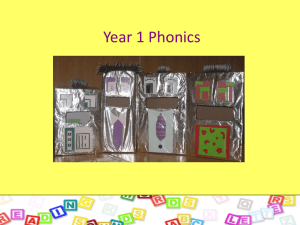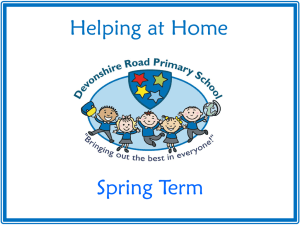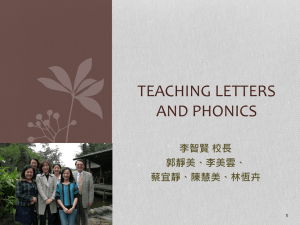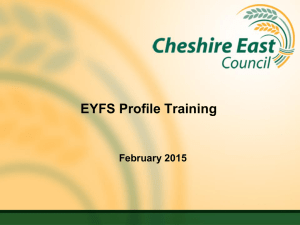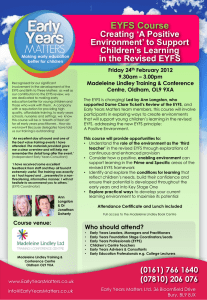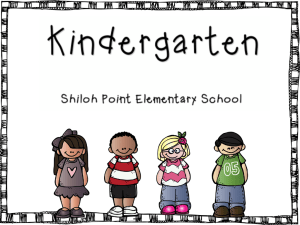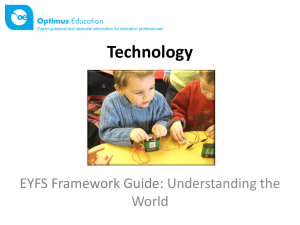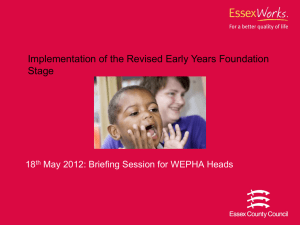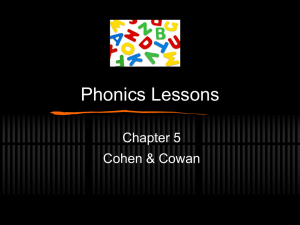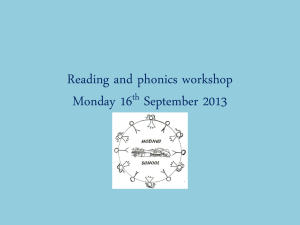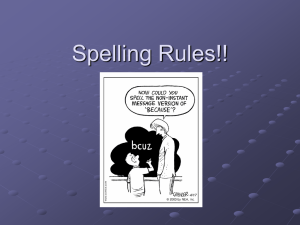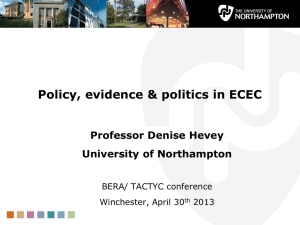Kildwick CE VC Primary School Early Years Foundation Stage
advertisement
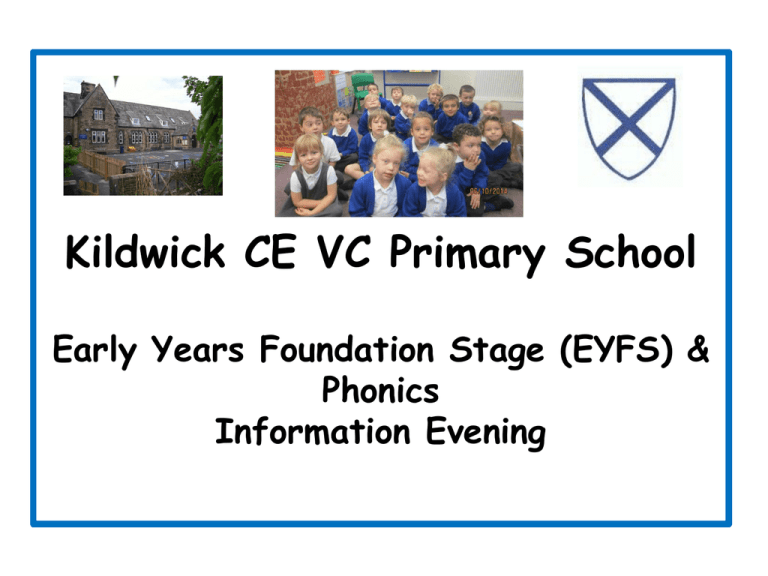
Kildwick CE VC Primary School Early Years Foundation Stage (EYFS) & Phonics Information Evening Early Years Foundation Stage (EYFS) The Early Years Foundation Stage (EYFS) is the stage of education for children from birth to the end of the Reception year. The EYFS Handbook 2014 states the EYFS seeks to provide: • quality and consistency in all early years settings, so that every child makes good progress and no child gets left behind • a secure foundation through learning and development opportunities which are planned around the needs and interests of each individual child and are assessed and reviewed regularly • partnership working between practitioners and with parents and/or carers • equality of opportunity and anti-discriminatory practice, ensuring that every child is included and supported. Early Years Foundation Stage (EYFS) Four guiding principles should shape practice in early years settings these are: • every child is a unique child, who is constantly learning and can be resilient, capable, confident and self-assured • children learn to be strong and independent through positive relationships • children learn and develop well in enabling environments, in which their experiences respond to their individual needs and there is a strong partnership between practitioners and parents and/or carers • children develop and learn in different ways and at different rates Prime & Specific Areas of Learning All areas of learning and development are important and inter-connected. Each area of learning and development must be implemented through planned, purposeful play and through a mix of adult-led and child-initiated activity. Play is essential for children’s development, building their confidence as they learn to explore, to think about problems, and relate to others. Children learn by leading their own play, and by taking part in play which is guided by adults. Prime Areas of Learning Communication and language development involves giving children opportunities to experience a rich language environment; to develop their confidence and skills in expressing themselves; and to speak and listen in a range of situations. Physical development involves providing opportunities for young children to be active and interactive; and to develop their co-ordination, control, and movement. Children must also be helped to understand the importance of physical activity, and to make healthy choices in relation to food. Personal, social and emotional development involves helping children to develop a positive sense of themselves, and others; to form positive relationships and develop respect for others; to develop social skills and learn how to manage their feelings; to understand appropriate behaviour in groups; and to have confidence in their own abilities. Specific Areas of Learning Literacy development involves encouraging children to link sounds and letters and to begin to read and write. Children must be given access to a wide range of reading materials (books, poems, and other written materials) to ignite their interest. Mathematics involves providing children with opportunities to develop and improve their skills in counting, understanding and using numbers, calculating simple addition and subtraction problems; and to describe shapes, spaces, and measures. Understanding the world involves guiding children to make sense of their physical world and their community through opportunities to explore, observe and find out about people, places, technology and the environment. Expressive arts and design involves enabling children to explore and play with a wide range of media and materials, as well as providing opportunities and encouragement for sharing their thoughts, ideas and feelings through a variety of activities in art, music, movement, dance, role-play, and design and technology. Characteristics of Effective Learning The ways in which the child engages with other people and their environment – playing and exploring, active learning, and creating and thinking critically – underpin learning and development across all areas and support the child to remain an effective and motivated learner.’ Assessment When children start in September within the first two weeks we carry out a baseline assessment. This supports us in knowing where your child is working at and what to plan next to support their learning and development. Assessment throughout the year is gathered in your child’s Learning Journey. We really appreciate your involvement in your child’s Learning Journey. The Early Learning Goals (ELG’s) Each of the Prime & Specific Areas of Learning has its own set of Early Learning Goals which show what most children are expected to achieve by the end of Foundation Stage. There should be a handout in your pack which tells you what the ELG’s are. The Profile is completed by myself and takes into account your child’s Learning Journey including Observations, Focus child learning stories and any contributions from home. There are three different levels in which your child can achieve in the Profile which are: Expected – has met the ELG’s Exceeding – is working further than the ELG’s Emerging – not yet meeting the ELG’s Further information The Foundation years website is very informative and interesting if you would like to find out more about EYFS. Here is the link: http://www.foundationyears.org.uk/ Phonics Hopefully at the end of the evening you will: •Understand more about what phonics is and how we teach it at school. •feel more confident in supporting us in teaching your child phonics. How do we teach Phonics and support children’s reading We follow the Governments Guidance: Letters and Sounds As you are already aware the children have started Phase 2. The purpose of this phase is to teach at least 19 letters, and move children on from oral blending and segmentation to blending and segmenting with letters. By the end of the phase many children should be able to read some VC and CVC words and to spell them either using magnetic letters or by writing the letters on paper or on whiteboards. During the phase they will be introduced to reading two-syllable words and simple captions. They will also learn to read some high-frequency ‘tricky’ words: the, to, go, no. Phonemes A Phoneme is the smallest unit of sound in a word Pronouncing the phonemes correctly is very important. e.g. the letter s is pronounced sssss and not suh. A good way to ensure you are saying the sound correctly is to use Oxford Owl which is a fantastic website with the sounds already recorded on so you can hear how to say the sound correctly. Lets have a look: http://www.oxfordowl.co.uk/for-home/reading-site/expert-help/phonics-made-easy Grapheme These are the letters that represent the phoneme. The grapheme could be 1 letter, 2, 3 letters or more. E.g. A digraph has 2 letters and a trigraph has 3 letters. Grapheme Frames Now if we have a look at the following words How many sounds are in these words? Sound buttons cat boat high Phoneme fingers VC and CVC words C and V are abbreviations for ‘consonant’ and ‘vowel’. VC words are words consisting of a vowel then a consonant (e.g. am, at, it) CVC words are words consisting of a consonant then a vowel then a consonant (e.g. cat, rug, sun). Words such as tick and bell also count as CVC words – although they have four letters, they have only three sounds. For example, in the word bell, b = consonant, e = vowel, ll = consonant. Getting ready for writing We will model how to form letters (graphemes) correctly, so that children are able to use the correct letter formation. These skills develop over a long period of time. In the early phonic phases children can use letter cards or magnetic letters to demonstrate their knowledge of phonics. Writing in lower-case letters We shall be teaching lower-case letters, as well as capital letters. As most writing will be in lower-case letters it is useful if you can use these at home. A good start is for your child to write their name correctly, starting with a capital letter followed by lower-case letters. Phase 3 The purpose of this phase is to: •teach more graphemes, most of which are made of two letters, for example, ‘oa’ as in boat •practise blending and segmenting a wider set of CVC words, for example, fizz, chip, sheep, light •learn all letter names and begin to form them correctly •read more tricky words and begin to spell some of them •read and write words in phrases and sentences. Phase 4 The purpose of this phase is for: • Children continue to practise previously learned graphemes and phonemes and learn how to read and write: • Children to learn CVCC words: tent, damp, toast, chimp • Children to learn more tricky words and continue to read and write sentences together. Reading – What happens at school As you will be aware your child will have started to bring home a reading book. At first the books have no words in and are an opportunity for you to: -Talk about the book and what is happening by looking at the pictures -Make up the story Your child will then move on to books with just a few words and then progress on to the next set of books in which they will use their phonics skills to help them to read. It is really important to make reading enjoyable. Here are some suggestions: -Try not to read when your child is tired -If you notice your child is tired or starting to struggle take it in turns to read a sentence each or just read the book to your child -Stickers and smiley faces in reading record always help -Share a love of reading with your child by showing them you are reading books and read other fiction and non fiction books together Thank you very much for attending the Information Evening we hope it has helped you to understand the EYFS and Phonics a little bit more. We do have a small questionnaire that we would be grateful if you could fill in to help us to further develop the things that we are doing. Thank you!
